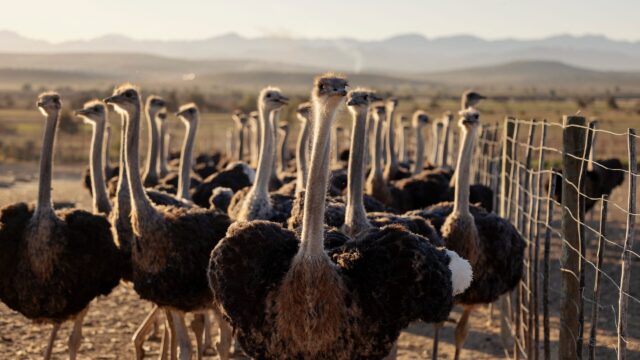Orwell Watch: The Great Canadian ‘Ostrich Cull’

On Friday, Canadian Broadcasting Corporation anchor Andrew Nichols tossed to correspondent Caroline Barghout in Edgewood, British Columbia for one of the most uncomfortable on-site TV reports ever. Barghout spends an agonizing minute and six seconds searching for creative ways to deliver a story about the Canadian government gunning down 330 ostriches without using key words like “kill” or “dead.”
Barghout’s standup script would deserve its own exhibit in the Newseum, if the place still existed:
Right now, it is very quiet here. Uh, it’s actually eerily quiet. We had been here a few times over the past few weeks, and we always would see ostriches, and now we’re not seeing ostriches. And as you mentioned, the Canadian Food Inspection Agency has said that it has completed the cull of the ostriches.
The correspondent wasn’t finished:
After conveying a statement from the CFIA that “experienced marksmen would be the best and most appropriate and most humane option” to “conduct this cull,” Barghout described the post-event location of the story’s main characters in a way that carefully avoided reference to their current level of, well, aliveness:
So they brought in professional marksmen to conduct this call on this property. We know that the birds are still on the property. We don’t know where they will be moved to now that the cull is done.
Having Barghout stand in front of a wall of hay bales strategically erected by the Royal Canadian Mounted Police and summarize the affair as “Previously, we saw ostriches, but now we do not see ostriches” was a sadly perfect mix of news-speak and Newspeak. Once again, the CBC fulfilled Canada’s historical mandate to preview what news delivery will look like in a post-misinformation universe.
The Canadian Food Inspection Agency (CFIA) decided last year that the animals required termination after some tested positive for Avian Flu. Still, the government came under intense criticism not just for carrying out a procedure not all felt was necessary, but for doing it in a gruesome manner, gunning birds down in “kill boxes” under cover of darkness while activists and owners of the Universal Ostrich Farm screamed from a distance.
When a New York billionaire named John Catsimatidis got involved in a campaign to stop the “cull” and Trump administration figures like Robert F. Kennedy and Medicare and Medicaid Administrator Dr. Mehmet Oz tried to intervene, the Great Ostrich Cull somehow turned into a “Republicans Pounce” story, with Politico for instance running a headline, “How a flock of Canadian ostriches became an all-time MAHA cause.” A BBC headline even went so far as to describe the story as the “ostrich cull saga that captivated RFK, Jr.,” explaining that ostriches were an “unlikely political symbol,” since “culls like this are often conducted without fanfare.”

The linguistic tap-dancing around the ostrich version of the Kronstadt Massacre would be less unnerving, were it not for the intersection of Canada’s aggressive word-twisting during the Covid pandemic and the more recent literary inventions around the country’s euthanasia craze. At a time when wide-scale misery seems to be in fashion across the political spectrum (Michelle Obama’s new coffee-table book Look is 304 pages about what a burden it was to have to dress as First Lady), Canada in 2021 quietly opened the door on mass Kevorkianism for people not merely not terminal, but potentially not even sick.
The country that year amended a program called Medical Assistance In Dying — MAID according to the grim acronym — changing the eligibility requirement from assisted suicide for those whose natural deaths were “reasonably foreseeable” to those with a “grievous and irremediable medical condition.” In a flash, assisted suicide (rebranded as “assisted dying”) became one of the country’s leading causes of death. One out of every twenty Canadians who died in 2023 were “assisted” deaths, a rate higher than deaths from “Alzheimer’s and diabetes combined,” as The Atlantic put it. While outlets like the New York Times and the BBC uncharacteristically expressed unease with a possible “slippery slope” effect, there’s comparatively little controversy in Canada, where 86% of the public reportedly approves of the changes in polls.
I wouldn’t feel so uneasy about all this if it weren’t for the language. A lot of thought has been put into how governments market state-assisted (or mandated, in the case of the ostriches) death. Assisted-dying hospices have been re-christened in some quarters as “MAIDhouses,” a term that sounds like a harmless new tapestry color or flavor of geriatric ice cream. “MAIDhouse” is also the name of a non-profit devoted to helping people eligible for assisted dying receive support in a “supportive, inclusive and comfortable setting.” Moral arguments against suicide have mostly vanished outside Catholic publications. There is something deeply troubling in the combination of relentless media coverage of how hard life is for a widening class of victim groups, and the sudden appearance of an instant legal pass to a better place for All Who Ail.
Most of the stories that have come out about “assisted dying” up north focus on people in horrible physical pain from diseases like spina bifida or cerebral palsy, but Canada is also currently scheduled to begin allowing euthanasia/suicide/assisted dying for people suffering from mental illness only — even depression, theoretically — on March 17, 2027.
I wonder if they will call it “assisted culling” by then.
https://www.racket.news/p/orwell-watch-the-great-canadian-ostrich
